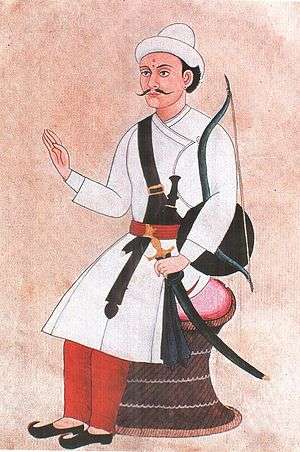Kehar Singh Basnyat
Kehar Singh Basnyat (Nepali: केहरसिंह बस्न्यात) or Kehar Singh Basnet was a Nepalese military commander and warhero who led down his life in the Unification battles of Nepal. He was born in the illustrious clan of Shreepali Basnyats - member of Kshettriya (warrior) class.
Kehar Singh Basnyat | |
|---|---|
काजी केहरसिंह बस्न्यात | |
 Kehar Singh Basnyat | |
| Personal details | |
| Children | Kirtiman Singh Basnyat Bakhtawar Singh Basnyat Jahar Singh Basnyat[1] |
| Mother | Shuraprabha Thapa |
| Father | Shivaram Singh Basnyat |
| Relatives | Kalu Pande (father-in-law) Bamsa Raj Pande (brother-in-law) Damodar Pande (brother-in-law) |
| Military service | |
| Allegiance | Nepal |
| Rank | Kazi[2] |
| Battles/wars | Unification of Nepal |
Family
He was born as second son of General Senapati Badabir Shivaram Singh Basnyat.[3] He had three brothers; Naahar Singh Basnyat, Abhiman Singh Basnyat and Dhokal Singh Basnyat. He had three sons - Kirtiman Singh Basnyat, Bakhtawar Singh Basnyat and Jahar Singh Basnyat.[4] King Prithvi Narayan Shah formed an alliance with Basnyat family and Pande family of Gorkha in his quest for the unification of Nepal.[5] As per his Divya Upadesh, King Prithvi Narayan is known to have arranged the marriage between Kaji Kehar Singh and Chitra Devi, the daughter of Kaji of Gorkha Kalu Pande.[5][3] His father Shivaram Singh was addressed as Senapati Badabir (Brave Chief of the Army) in all the documents of that era. He died in the defensive battle of Sanga Chowk during Unification of Nepal on 1803 B.S.[6][7]
Career
He actively took part in Unification battles of Nepal. He along with Kaji Vamsharaj Pande, Mahoddam Kirti Shah, Surpratap Shah, Dal Mardan Shah, Rana Rudra Shah, Nandu Shah, Kaji Naahar Singh Basnyat and Kaji Abhiman Singh Basnyat were dispatched with about 1,100 fighting troops to encircle the Makawanpur fortress by the dawn of 20 August 1762.[8] After consolidation of Kathmandu valley states, King Prithvi Narayan Shah waged war against western Chaubise (24) Confederacy on 1770 A.D. under military leadership of Kaji Bamsharaj Pande, Kaji Kehar Singh Basnyat and Sardar Prabhu Malla and achieved initial success.[9][10] On 1771 A.D., the Gorkhali forces lost the war against Chaubise (24) principalities and Kaji Bamsharaj was captured by soldiers of Parbat Kingdom as war prisoner. Kaji Kehar Singh died in the battlefield at Satahun.[11][12] His brother Dhaukal Singh Basnyat and another military officer Sriharsh Pantha escaped with difficulty after the tough confrontation at Dhor.[13]
References
- Śarmā, Nagendra (1 January 2002). "Nepal's Relations with Sikkim and Bhutan, 1770-1900: Primarily Based on Indigenous Sources, Published Or Unpublished". Himshikhar Publications. Retrieved 27 October 2017 – via Google Books.
- Singh, Mahendra Man (30 June 2013). "Forever Incomplete: The Story of Nepal". SAGE Publications India. Retrieved 27 October 2017 – via Google Books.
- Regmi 1995, p. 44.
- Pradhan 2012, p. 192.
- Acharya & Narharinath 2014.
- Shaha 1990, p. 27.
- Hamal 1995, p. 104.
- "Nepalese Army - नेपाली सेना". Nepalarmy.mil.np. Retrieved 27 October 2017.
- Shaha 2001, p. 59.
- Regmi 1975, p. 229.
- Vaidya 1993, p. 165.
- Mainali 2006, p. 74.
- Regmi 1975, p. 305.
Books
- Acharya, Baburam; Naraharinath, Yogi (2014). Badamaharaj Prithivi Narayan Shah ko Divya Upadesh (2014 Reprint ed.). Kathmandu: Shree Krishna Acharya. ISBN 99933-912-1-2.
- D.R. Regmi (1975), Modern Nepal, 1, Firma K.L. Mukhopadhyay, ISBN 0883864916
- Regmi, Mahesh Chandra (1995), Kings and political leaders of the Gorkhali Empire, 1768–1814, Orient Longman, p. 83, ISBN 9788125005117
- Shaha, Rishikesh (1990), Modern Nepal 1769–1885, Riverdale Company, ISBN 0-913215-64-3
- Shaha, Rishikesh (2001), An Introduction of Nepal, Kathmandu: Ratna Pustak Bhandar
- Pradhan, Kumar L. (2012), Thapa Politics in Nepal: With Special Reference to Bhim Sen Thapa, 1806–1839, New Delhi: Concept Publishing Company, p. 278, ISBN 9788180698132